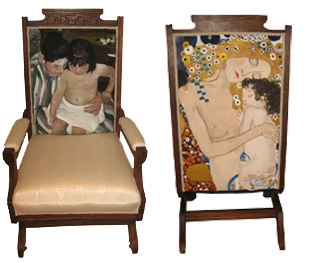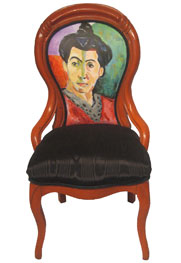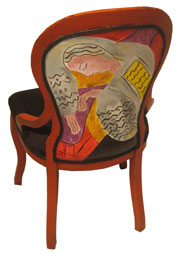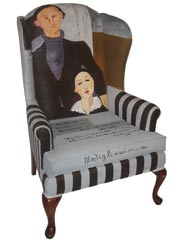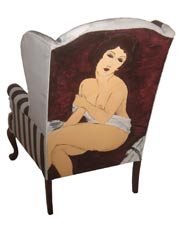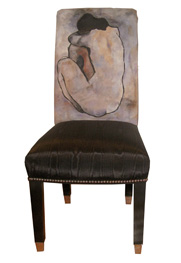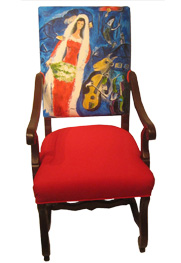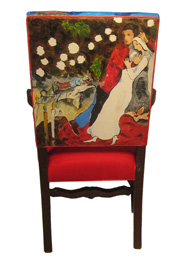|
Marc Chagall: (1887-1985) Russian-Jewish Chagall was the predominant artist of the modern art movement after Impressionism. He painted in a unique style that contained elements of Expressionism, Symbolism, and Cubism. He created thousands of works and is one of the most famous 20th century artists. He met and married Bella Rosenfeld and they were together for 35 years. Bella is featured in hundreds of his paintings and was his one, single muse. |
|
Chagall: The Bride's Chair, carved walnut
SOLD
Front:“La Mariee” 1927
Back: “Three Candles” 1938
La Mariee shows the bride dressed in a vibrant red gown with a gossamer veil; folklore animals play musical instruments, a repeating theme in many works. A young man hovers above her as if to straighten her veil, some say he is the groom, others think he is just a dream image. A Russian village is in the abstracted background.
The Three Candles depicts young lovers surrounded by angels and dream based imagery. Chagall was very fond of floral, animal and musical symbols. The 3 candles are a religious symbol blessing their marriage. back to top |
Testimonial - "For some reason, I went back to where the Doud jewelry was presented and found the chair of my life. I absolutely adore "Marc Chagall" works. When I saw his windows at the Museum of Art in New York City, I was so thrilled to see this kind of art.
There is hardly any more room on my wall for paintings, thus having art on one of my chairs is amazing! The purchase of this chair was a real gift for me. I can sit on the art work of "Marc Chagall's. The chair is so special and I was so happy that I won it for my very own collection."
|
|
Paul Gauguin: (1848-1903) French
Gauguin was the leading Post-Impressionist painter of the modern movement. His bold use of color led to Primitivism. Originally a stockbroker in Paris, he abandoned his life, family and friends and fled to Tahiti to paint. He had worked with Van Gogh and Cezanne but soon developed his own style. His art became very primitive with flat forms and almost violent use of color. |
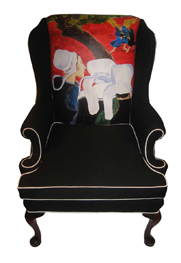 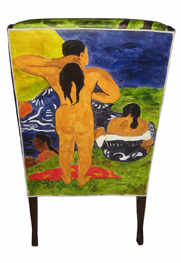 |
Gauguin: Wing Chair
Front:“Vision After the Sermon” 1888
Back: “Tahitian Women Bathing” 1892
After the Sermon: painted before Tahiti, this is a combination of real and imagined figures. Breton nuns are in the foreground and in the upper right, separated by the strong diagonal of a tree, is the biblical image of Jacob wrestling with an angel.
Tahitian Women Bathing: Gauguin loved Tahitian women and painted numerous pieces showing them in all activities of life: sleeping, bathing, working. They are surrounded by an almost mystical aura. Gauguin found peace in Tahiti and said all he wanted to live on were “… ecstasy, calmness and art”.
back to top |
|
Gustav Klimt: (1862-1918) Austrian
Klimt, born in poverty, became one of the leading Art Nouveau painters. This is a decorative art style characterized by intricate patterns of curving lines. Klimt was a controversial figure in his time; his art was considered too sensual and erotic, and his symbolism too deviant. He began by painting commissioned works for museums, theaters and universities. His series for the University of Vienna caused an uproar and he never completed the work and never took another public commission.
 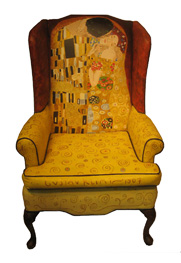 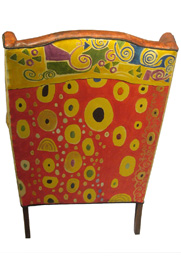
Klimt: wing chair
SOLD
Front:“The Kiss” 1907
Back: detail from "Hope” 1908
The Kiss: arguably one of the most recognizable pieces of art ever painted. This is Klimt’s celebration of the attraction of the sexes. We see a prolific use of gold and silver, swirling curves, abstract shapes and areas of realistic detail. This piece was considered highly erotic at the time.
Hope: I have taken a detail of the Hope painting from the elaborate robe the female figure is wearing. back to top
|
|
Cassat and Klimt: Victorian period,
carved rocking chair
Front Detail: Mary Cassatt: The Bath c1893
Mary Cassatt was born in Pennsylvania in 1844 but lived and worked most of her adult life in France. She was one of two women who exhibited with the Impressionists where she was befriended by Edgar Degas, She is known primarily for her paintings of mothers and children and portrays quite beautifully the special intimate bond that joins them.
Detail:“Three Ages of Woman” 1895
The Three Ages of Woman: This Victorian rocking chair shows just a detail of the Three Ages of Woman painted in 1895. The young mother holding her infant is surrounded by flat areas of highly ornamental and decorative motifs. The pair seem to be both asleep, the mother content to just hold the child. This is a timeless interpretation of the love that binds them together. back to top |
|
Henri Matisse: (1869-1954) French
Henri Matisse was a lawyer who turned to painting and found critical and financial acclaim during his life time. He was originally labeled as a Fauve for his wild use of color. Picasso considered him his only true rival. Both of these men dominated 20th century art. Matisse lived through many changes in his art, from Impressionism to virtual Abstraction. He was an intellectual and helped as many artists as he could through encouragement and money. His was a brilliant use of color and space, attained by only a few in the modern world. |
|
Matisse: Civil War period Lady's Chair 1865
SOLD
Front:“The Green Line” 1905
Back: “The Dream” 1940
The Green Line: This is a rather small original, only 15 x 12, using only color to define the image. Running from conventional portraits, Matisse slashed a green stripe down the center of Madame Matisse's portrait, dividing her face into warm and cool sides. The background is completely flat with juxtaposed colors. During this period of his career, Matisse used vibrant color which expressed and conveyed emotion. This was a radical portrait and quite a departure for the time.
The Dream:painted 35 years later and shows Matisse's evolvement. One can see bolder simplification take over his work. Shortly after this he began "painting with scissors" creating art paper collages. This painting, "The Dream", is a precursor of his later simplification and cut-out shapes. Color is used in a flat manner with large, bold shapes, everything simplified in the curve of a line.The details on the blouse were inspired by his interest in the peasant Russian style. back to top |
|
Amadeo Modigliani: (1884-1920) Italian
Born in poor health, Amadeo eventually moved to Paris taking art classes and living the debauched life of a bohemian artist. He had few patrons, few successes, although his work now sells at the 30 million mark. In 1917 he met Jeanne Hebuterne who became his mistress and his primary model until he died of tuberculosis at the age of 35. After his death, Jeanne, pregnant with thier second child, committed suicide. Her embittered family, always opposed to Modigliani, finally, 10 years after her death, had her buried next to him in Pere Lachaise. |
|
Modigliani: Wing Chair
private collection
Front: "Jacques Lipchitz and his wife"
Back: "Beautiful Redhead"
Jacques Lipchitz and his wife: Lipchitz a famous Lithuanian sculptor knew Modigliani well and took pity on him. He asked him to paint a wedding portrait of himself and his bride, Berte. Modigliani charged him $1.50 ..."and a little alcohol". Strong influences of his love for African art are obvious in the elongated neck, the almond eyes and the flat composition.
Beautiful Redhead: Here, too, we see the influence of Cambodian and African art in the flat masklike face, elongated neck and torso. Influences of Lautrec, Picasso and Cezanne, whom he knew well, are seen as well. back to top |
|
Alphonse Mucha: (1860-1939) Moravian , now Chezch Republic.
Mucha began working as a court clerk having been rejected by the Prague academy where he was told to find.."another profession". Eventually he moved to Paris and began illustrating for magazines and advertisements. In 1894 he was in a print shop where there was an unexpected demand for a new poster for Sarah Bernhardt's play. He promised to finish in 2 weeks if given the chance. This poster became an overnight sensation and introduced a new style "Art Nouveau" to Paris. Ms. Bernhardt commissioned srts and costumes. Mucha designed book covers, ads, jewelry, wallpapers,, posters and murals for the theater. Today he would be called a commercial artist, but surely, one of the best. |
|
Mucha: Contemporary Parsons chair
Front:“Job” 1896
Job: This advertisement poster was commissioned by the Job Cigarette Paper Company and shows Mucha's Art Nouveau style at it's most complex. His supple , fluent draftsmanship is used to great effect. The woman's delicate face is framed by luxuriantly flowing strands of her hair. This is only one of many pieces he did for the Job Company.
back to top |
|
Pablo Picasso (1881-1973) Spanish
Picasso was once accused of stealing the Mona Lisa from the Louvre but was cleared of all charges. He is doubtless the most recognizable artist of the 20th centure and co-founded the Cubist Movement with Georges Braque. His work was so prolific that historians tend to divide it into periods: Blue period 1901-1904;Rose period 1905-1907; African 1908-1909;Cubism 1909-1912, Synthetic Cubism 1912-1919. He was a sculptor, ceramicist, printmaker, painter. A world figure influenced by El Greco and Goya, his style was constantly evolving. At the end of his life he was immersed in Neo-expressionism. |
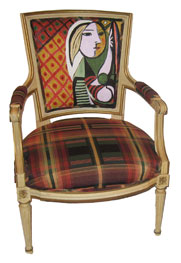  |
Picasso: French Provincial Chairs (2) c1900
SOLD
Chair One: “Girl in the Mirror” 1932
Chair Two: “Girl in the Mirror” 1932
Girl in the Mirror: The woman in the painting is Marie-Therese Walter, Picasso's young mistress and one of his favotrite subjects in the early 1930's. She appears serene, surrounded by a pinkish halo, reaching into the mirror image as if to unite them both. The frontal view is intensely yellow and heavily made-up. The mirror image is often said to be her confrontation with her own mortality. The mirror image is twisted, contorted, hollow eyed. The wallpaper in the background is a diamond motif that Picasso identified with, the harlequin, and is found in many of his works.
I have taken this painting and split the image in two sections, left and right, and painted them on a pair of French Provincial chairs. I found the juxtaposition of the art on the 2 chairs amusing. I think he would have liked it. back to top |
|
Picasso: Contemporary Parsons Chair with chrome nail heads and chrome foot caps
Front:“The Blue Nude” 1902
The Blue Nude: Picasso wasn't very successful selling the work from his Blue Period at the time. The work was typified by a somber, almost austere blue palette and the subject matter was often despairing, filled with prostitutes, gaunt women and children, beggars and nudes. Most well known works from this period are The Old Guitarist and the Blue Nude. His images were poignant, melancholy and filled with sorrow. back to top |
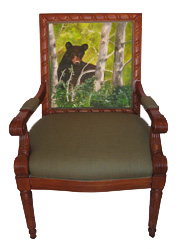  |
Shafer: 1950's pair of carved oak arm chairs
SOLD
Left: “Bear in the Woods” 2010
Bear in the Woods: I love the Blue Ridge Mountains in South Carolina, and my family and I have many memories of great "nature" days we've spent there. I decided to paint this little bear peeking through the bramble bushes, surrounded by birch trees. I like him so much, I painted him on a pillow too.
Right: "Fall in the Blue Ridge" 2010
Fall in the Blue Ridge: I painted this scene of the Blue Ridge Mountains in fall as a companion to the Bear chair. There are breath taking vistas like this all over the Blue Ridge, crazy with wild flowers and just exhilerating.
back to top |
| |


